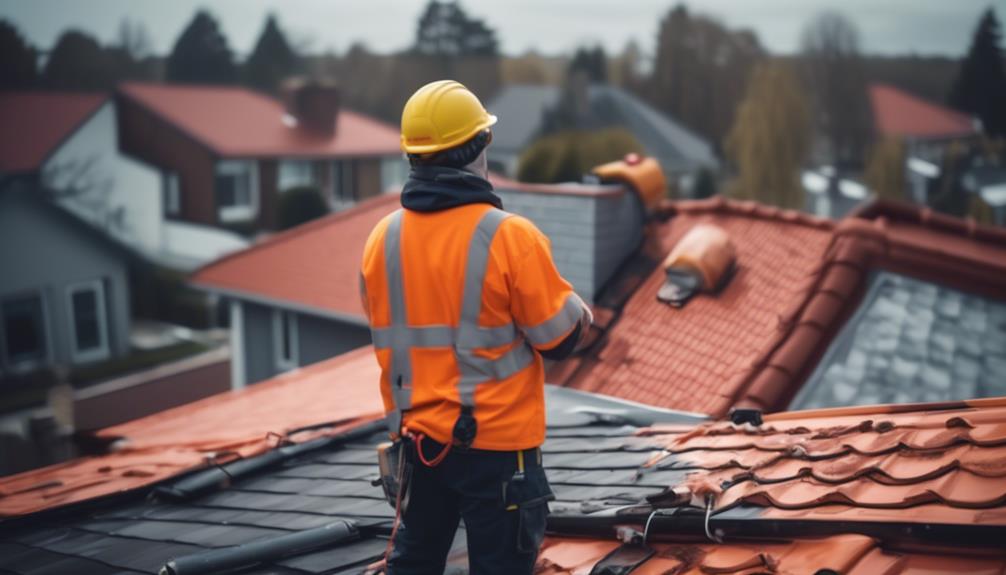When it comes to maintaining the integrity of our homes, few things are as important as a solid roof. It serves as our first line of defense against the elements, keeping us safe and dry. However, as time goes on, even the most well-built roofs can develop leaks.
And let's face it, dealing with a leaky roof is never a pleasant experience. That's why it's crucial to have effective strategies in place for durable roof leak detection. By implementing these strategies, we can not only save ourselves from the headaches and expenses associated with water damage, but also ensure the longevity of our roofs.
So, how can we effectively detect and address roof leaks? Stay with us as we explore the best methods and practices for keeping our homes leak-free.
Importance of Roof Leak Detection

Roof leak detection is of utmost importance in maintaining the structural integrity and longevity of a building. Identifying and addressing roof leaks promptly can prevent significant damage to the building's interior and its contents. By detecting leaks early on, property owners can avoid costly repairs and potential disruptions to their daily operations.
One of the primary benefits of roof leak detection is the preservation of the building's overall structure. Roof leaks can lead to water infiltration, which can weaken the building's foundation, walls, and supporting structures. Over time, this can compromise the stability and safety of the entire building. Regular leak detection allows for timely repairs, ensuring that the building remains structurally sound.
Another significant benefit of roof leak detection is the prevention of mold and mildew growth. Moisture from roof leaks creates a conducive environment for mold and mildew to thrive. These microorganisms can cause health issues for occupants and lead to further damage to the building's materials. By detecting and addressing leaks promptly, property owners can mitigate the risk of mold and mildew growth.
Signs of a Roof Leak
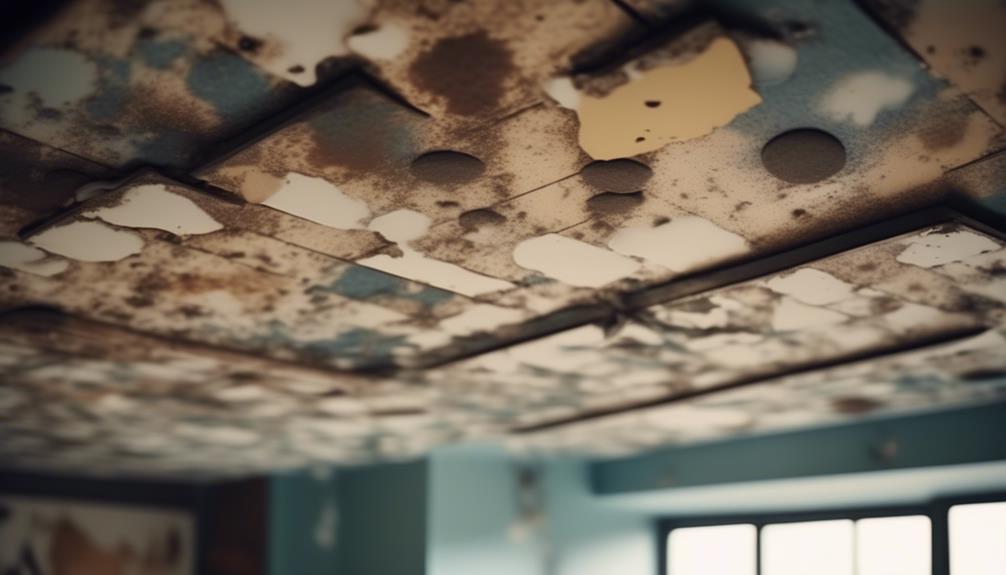
Detecting a roof leak early on is crucial for preventing extensive damage and maintaining the structural integrity of a building. To effectively detect a roof leak, it's important to be aware of the signs of water damage.
One common sign is the presence of water stains on the ceiling or walls. These stains can appear as discolored patches or streaks and are often accompanied by a musty odor.
Another sign is the formation of mold or mildew on walls or ceilings, which thrive in moist environments. Additionally, peeling or bubbling paint can indicate the presence of water damage.
It's also important to inspect the attic for signs of a roof leak, such as damp insulation, rotting wood, or water stains on rafters or beams.
Lastly, water dripping or pooling in areas of the building is a clear indication of a roof leak.
Common Causes of Roof Leaks
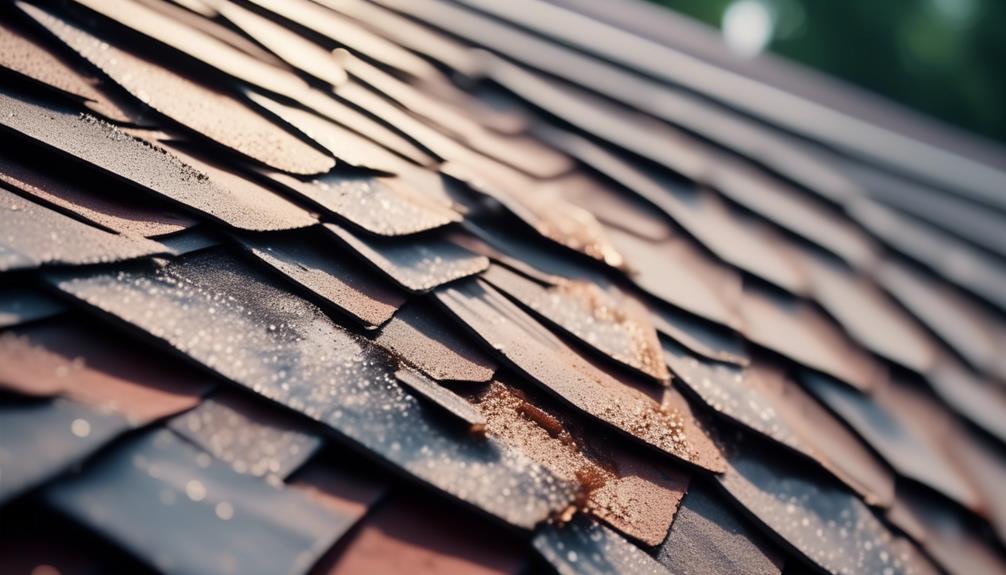
Now that we've established the importance of detecting roof leaks early on, let's explore the common causes behind these troublesome leaks. Understanding the causes of leaks can help homeowners take proactive measures to prevent them and minimize potential damage.
Here are some common causes of roof leaks:
- Age and deterioration: Over time, roofs naturally deteriorate due to exposure to the elements. This can lead to cracks, gaps, and weakened areas that allow water to seep through.
- Poor installation or workmanship: If a roof isn't installed correctly or if there are mistakes during the installation process, it can create vulnerabilities that may result in leaks.
- Damaged or missing shingles: Shingles can become damaged or go missing due to severe weather conditions, such as high winds or heavy rain. This leaves the underlying layers of the roof vulnerable to water infiltration.
- Clogged gutters and downspouts: When gutters and downspouts are clogged with debris, they can overflow and cause water to pool on the roof. This can lead to leaks and water damage.
- DIY repairs and maintenance: Attempting to fix a roof without proper knowledge and experience can often do more harm than good. DIY repairs may not address the root cause of the leak and can result in further damage.
The Role of Professional Leak Detection

Professional leak detection plays a crucial role in identifying and addressing roof leaks in a timely and effective manner. With the advancements in technology, professionals are equipped with state-of-the-art tools and techniques to accurately locate and repair leaks. By utilizing specialized equipment and expertise, professional leak detection services offer several benefits.
One of the key benefits of professional leak detection is the role of technology in the process. Advanced thermal imaging cameras and moisture meters enable professionals to identify hidden leaks and moisture intrusion points that may not be visible to the naked eye. These tools provide accurate and precise results, allowing for targeted repairs and minimizing damage to the roof structure.
Another advantage of hiring professional services is the expertise and experience they bring to the table. Trained technicians have the knowledge and skills to assess the condition of the roof, identify potential causes of leaks, and recommend appropriate solutions. They can also provide preventive maintenance strategies to help extend the lifespan of the roof and prevent future leaks.
Benefits of Early Leak Detection

Early leak detection offers a range of advantages for maintaining the integrity of a roof and preventing further damage. Here are some key benefits of early detection and the importance of taking timely action:
- Peace of mind: Identifying and addressing roof leaks early on can provide homeowners with peace of mind, knowing that their property is protected from potential water damage.
- Cost savings: Timely leak detection can save homeowners significant costs in the long run. By addressing leaks early, repairs can be more manageable and less expensive compared to extensive damage caused by undetected leaks.
- Extended roof lifespan: Early leak detection allows for prompt repairs, which can extend the lifespan of a roof. By addressing leaks promptly, the overall structural integrity of the roof is preserved, preventing further deterioration.
- Protection of property and belongings: Roof leaks can lead to water damage to the interior of a property, including walls, ceilings, and personal belongings. Early detection and repair can help prevent such damage, preserving the value and condition of the property.
- Enhanced indoor air quality: Roof leaks can contribute to the growth of mold and mildew, which can negatively impact indoor air quality and pose health risks. Early detection and repair can prevent the spread of mold and ensure a healthier living environment.
Taking immediate action upon detecting a roof leak is crucial to minimize the potential damage and preserve the overall condition of a property. Early leak detection provides homeowners with numerous benefits, ranging from cost savings to peace of mind.
Tools and Equipment for Leak Detection
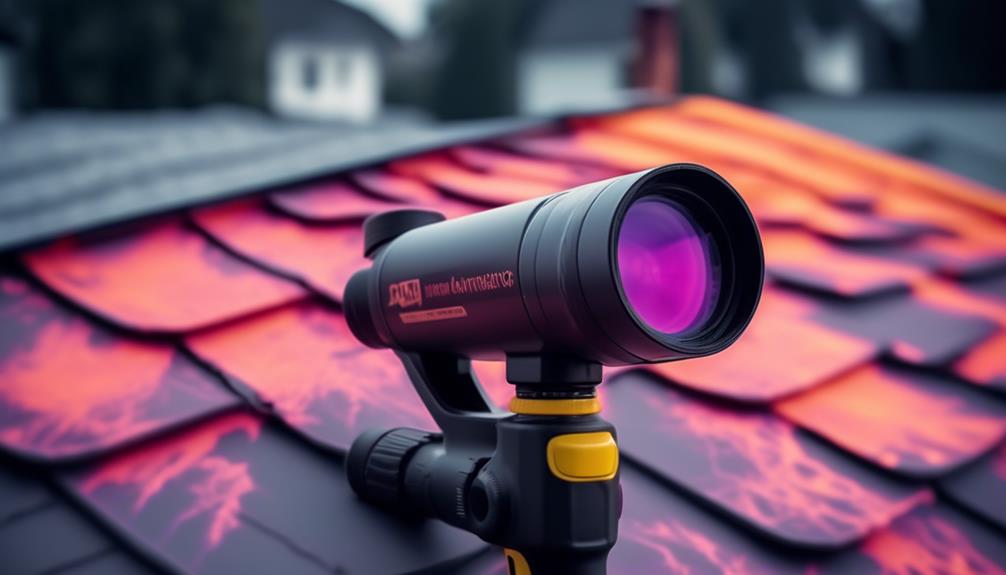
When it comes to leak detection, having the right tools is essential.
Some of the essential leak detection tools include moisture meters, thermal imaging cameras, and smoke generators. These tools allow us to accurately locate and identify leaks in roofs.
In addition to these basic tools, there are also advanced detection equipment available that can provide more detailed information about the source and extent of the leak.
Essential Leak Detection Tools
To effectively detect roof leaks, it's essential to have the right tools and equipment at hand. Here are the essential leak detection tools that will help you in your quest for leak-free roofs:
- Moisture Meters: These handy devices can accurately detect moisture levels in various roofing materials, helping you identify potential leak sources.
- Infrared Cameras: These advanced cameras can detect temperature variations on the roof's surface, making it easier to locate hidden leaks.
- Smoke Machines: By generating smoke, these machines can help visualize air leaks and identify areas where the roof may be compromised.
- Tracer Dyes: These fluorescent dyes can be injected into the roof's drainage system to track the path of leaks and identify weak points.
- Acoustic Listening Devices: These tools amplify the sound of water leaks, allowing you to pinpoint their exact location.
Advanced Detection Equipment
What are the advanced tools and equipment used for leak detection? When it comes to detecting leaks in roofs, advanced detection technology and innovative methods play a crucial role. These tools and equipment enable us to identify leaks accurately and efficiently, ensuring prompt repairs and preventing further damage. Below is a table showcasing some of the advanced detection equipment commonly used in the industry:
| Equipment | Description | Benefits |
|---|---|---|
| Infrared Cameras | Detects temperature variations, indicating areas of moisture | Non-invasive, identifies hidden leaks |
| Electronic Leak Detectors | Locates leaks by detecting electrical conductivity in water | Precise, quick identification of leaks |
| Smoke Machines | Releases smoke to identify air leaks in roofing systems | Effective for detecting hard-to-find leaks |
Techniques for Roof Leak Detection
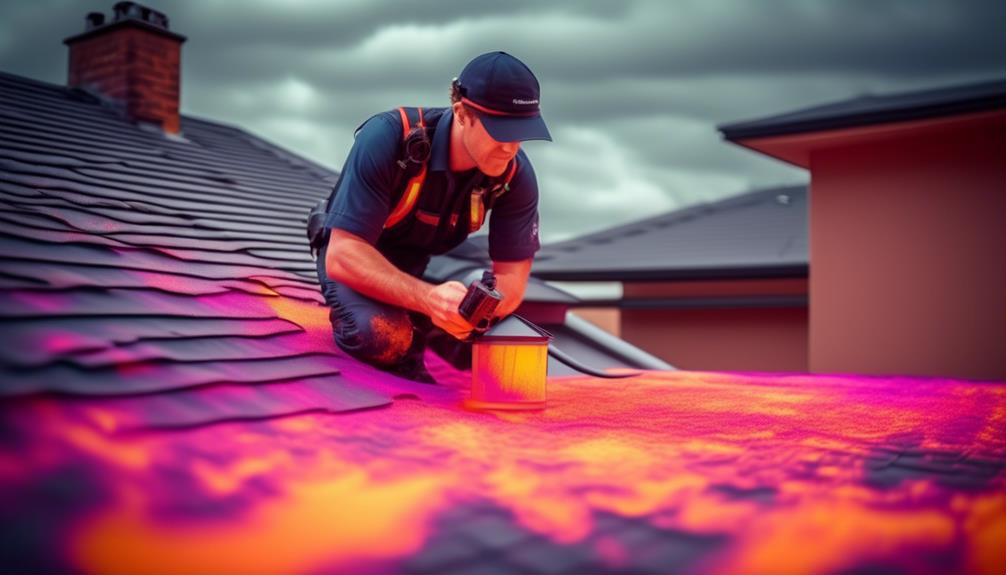
Various techniques can be employed to effectively detect roof leaks. When it comes to roof leak detection techniques, it's essential to employ effective leak detection methods to ensure the longevity and integrity of the roof. Here are two techniques that can help in detecting roof leaks:
- Visual Inspection: This technique involves carefully examining the roof for any visible signs of water damage, such as stains, discoloration, or mold growth. By conducting a thorough visual inspection, one can identify areas that might be prone to leaks and take necessary measures to fix them.
- Water Testing: This technique involves simulating rain by pouring water onto specific areas of the roof and observing for any signs of leakage. By systematically testing different sections of the roof, one can pinpoint the exact location of the leak and initiate the appropriate repairs.
Understanding Roofing Materials and Leak Detection

Understanding the different types of roofing materials is crucial for effective leak detection and maintenance of roofs. When it comes to roofing material selection, it's important to consider factors such as durability, weather resistance, and ease of maintenance.
Different materials have different properties that can affect their susceptibility to leaks. For example, asphalt shingles are a popular choice due to their affordability and ease of installation. However, they may be prone to cracking and lifting in extreme weather conditions, leading to potential leaks.
On the other hand, metal roofs are known for their durability and resistance to leaks, but they may require professional installation and periodic maintenance.
DIY leak detection can be performed by homeowners using simple techniques such as visual inspection, checking for water stains or damp spots, and using a hose to simulate rainfall and observe for any signs of leakage. However, it's important to note that professional inspection and repairs are recommended to ensure thorough and accurate leak detection.
Preventive Measures to Avoid Roof Leaks

To prevent roof leaks, homeowners can take proactive measures to maintain the integrity of their roofs. Here are some preventive maintenance tips that can help avoid roof leaks:
- Regular inspections: Regularly inspect your roof for any signs of damage or wear and tear. Look for cracked or missing shingles, gaps in the flashing, or any other potential issues.
- Clear debris: Keep your roof clean from debris such as leaves, branches, and dirt. Accumulated debris can trap moisture and lead to roof deterioration.
- Trim overhanging branches: Overhanging branches can rub against the roof, causing damage to the shingles or even puncturing the roof membrane. Trim these branches to prevent any potential leaks.
- Maintain gutters: Clean and maintain your gutters regularly to ensure proper water drainage. Clogged gutters can lead to water pooling on the roof, which can seep into the structure and cause leaks.
- Repair leaks promptly: If you notice any leaks or signs of water damage, address them immediately. Ignoring even small leaks can lead to larger, more costly issues down the line.
Hiring a Professional Leak Detection Service

When it comes to detecting roof leaks, hiring a professional leak detection service offers several advantages.
Their expertise in leak detection allows them to quickly identify the source of the problem and provide effective solutions.
These professionals also utilize advanced detection techniques, such as thermal imaging and moisture meters, to accurately pinpoint the exact location of the leak.
Expertise in Leak Detection
Hiring a professional leak detection service ensures efficient and accurate identification of roof leaks. With their expertise in leak detection techniques, these professionals can quickly locate the source of the leak and prevent further damage to your property.
Here are two reasons why hiring a professional leak detection service is crucial:
- Expertise: Professional leak detection services have the knowledge and experience to identify even the most elusive leaks. They use advanced equipment and techniques to accurately pinpoint the problem areas, saving you time and money in the long run.
- Peace of Mind: By entrusting the task to professionals, you can rest easy knowing that your roof is in good hands. They'll not only detect and fix the leaks but also provide recommendations for preventing future leaks, ensuring the durability and longevity of your roof.
Investing in a professional leak detection service is a wise decision that can help you avoid costly repairs and protect your property from potential damage.
Advanced Detection Techniques
By utilizing advanced detection techniques, a professional leak detection service can accurately pinpoint the source of roof leaks, ensuring efficient and effective repairs.
These advanced detection methods employ innovative leak detection techniques that go beyond traditional methods, allowing for more precise and reliable results.
One such technique is thermal imaging, which uses infrared cameras to detect temperature variations on the roof's surface. This can help identify areas where moisture is present, indicating a leak.
Another method is electronic leak detection, which uses low voltage electrical currents to locate leaks in the roof membrane. This non-destructive technique is particularly useful for flat roofs and can detect leaks even in hard-to-reach areas.
Timely and Accurate Results
For timely and accurate results in detecting roof leaks, it's advisable to enlist the services of a professional leak detection company. They've the expertise and tools necessary to quickly respond to your leak concerns and provide an accurate diagnosis.
Here are two reasons why hiring a professional leak detection service is essential:
- Prompt Response: Professional leak detection companies understand the urgency of roof leaks. They offer timely response, ensuring that leaks are identified and addressed promptly. This helps prevent further damage to your property and minimizes the risk of costly repairs.
- Accurate Diagnosis: Detecting the source of a roof leak can be challenging, as it may not always be evident from the surface. Professional leak detection services employ advanced techniques and equipment to accurately diagnose the problem. Their expertise allows them to identify hidden leaks and provide targeted solutions, saving you time and money.
Long-Lasting Solutions for Roof Leak Repairs
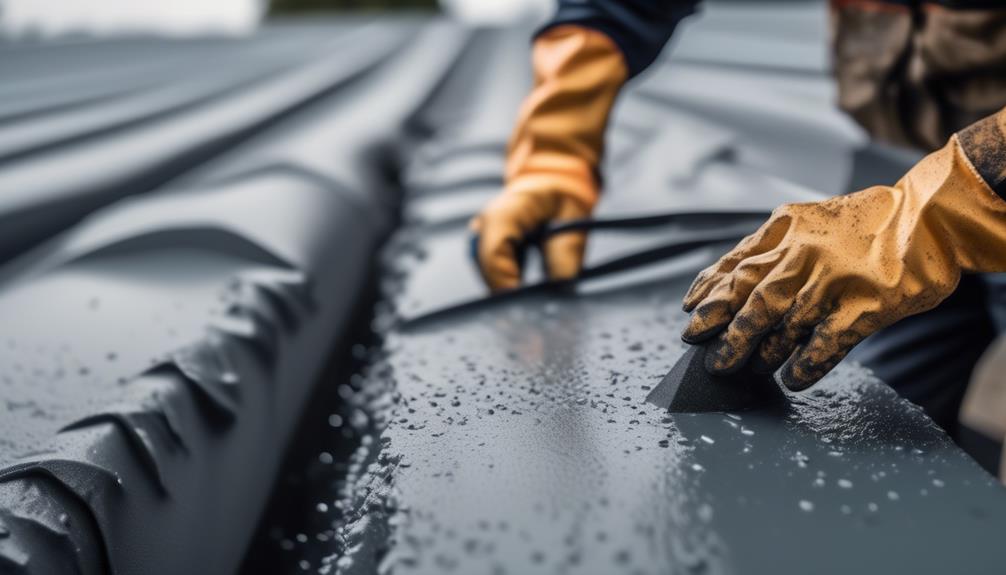
When it comes to long-lasting solutions for roof leak repairs, there are several effective methods that can be employed.
One option is to use high-quality roofing materials that are designed to withstand harsh weather conditions and prevent leaks. These materials, such as rubberized asphalt or modified bitumen, provide a strong barrier against water infiltration.
Additionally, utilizing advanced repair techniques, such as using sealants or coatings, can help reinforce weak spots and prevent future leaks.
Another effective method is to address any underlying issues that may be causing the leaks, such as damaged flashing or deteriorated shingles. By identifying and fixing these problems, the longevity of the roof can be extended, ensuring long-lasting protection against leaks.
Regular maintenance, including inspections and prompt repairs, is also crucial in preventing and addressing roof leaks.
Frequently Asked Questions
What Are the Potential Health Risks Associated With a Roof Leak?
Potential health risks associated with a roof leak can be serious. Mold growth is a common consequence, which can trigger allergies and respiratory issues.
Water damage can lead to weakened structural integrity, increasing the risk of collapses or accidents.
It's crucial to take preventive measures such as regular inspections and maintenance to avoid these risks. By addressing roof leaks promptly, we can protect our health and ensure the durability of our roofs.
Can Roof Leaks Cause Structural Damage to a Building?
Roof leaks can indeed cause structural damage to a building. The risks associated with these leaks include compromising the integrity of the building's structure.
Water seeping through the roof can weaken the foundation, rot wooden structures, and corrode metal components, leading to potential collapses or failures.
It's crucial to address roof leaks promptly to prevent further damage to the building's structure and ensure its long-term stability.
Are There Any Specific Roofing Materials That Are More Prone to Leaks?
When it comes to roofing materials, some are more prone to leaks than others. Common causes of leaks include improper installation, aging materials, and lack of maintenance.
Certain materials, such as asphalt shingles, may be more susceptible to leaks due to their composition and vulnerability to wear and tear over time.
It's important to choose durable roofing materials and regularly inspect and maintain your roof to prevent leaks and potential structural damage to your building.
How Often Should Roof Leak Detection Be Performed?
We recommend performing roof leak detection regularly to prevent any major damage. The frequency of roof inspections should be at least once a year, but it's wise to do it more often if you live in an area with severe weather conditions.
Look out for signs of a hidden roof leak such as water stains on the ceilings or walls, mold growth, or musty odors. Detecting leaks early can save you from costly repairs down the line.
Can Roof Leak Detection Be Done by Homeowners or Is It Always Necessary to Hire a Professional?
Roof leak detection can be done by homeowners, but it's not always necessary to hire a professional. With the right tools and knowledge, homeowners can identify and fix minor leaks. However, for more complex issues or if you're unsure of your capabilities, it's best to call in a professional.
They have the expertise to accurately diagnose the problem and provide durable solutions. It's important to weigh the cost of DIY efforts against the potential risks and benefits of hiring a professional.
